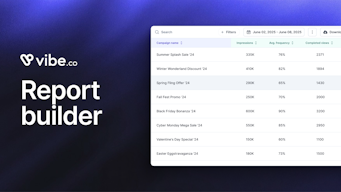How to read a CTV dashboard for maximum insight
One of the many exciting features to come out of a shift from linear television advertising to connected television advertising is the ability to gather and analyze campaign results in real time, modularly segmented by targeting metric (age, channel, geo, gender, interest, and more). Not only does real time reporting enable nimble campaign pivoting, but buying CTV ads programmatically instead of contractually, through private deals, means advertisers actually have a chance to get deep targeting insights from their campaigns (which they can then optimize as they are running.)
By taking some of the control away from media buyers who think they know exactly where to find their audiences and instead putting it (to a degree) in the hands of bidders with mature machine learning, advertisers now have the opportunity to learn something new about their audiences. Imagine that! After all, there’s a reason Henry Ford’s quote about horses still holds true: “If [he] had asked people what they wanted, they would have said a faster horse!” Advertisers are going to keep thinking they need faster horses when in fact they need…open auction CTV campaigns.
Case in point: if we asked traditional TV buyers where they wanted to buy, they would say primetime on the 2 channels they think they know their customers watch, but that’s a recipe for exorbitant pricing and thousands of wasted impressions. There’s a reason identity and segmentation are going through seismic shifts right now: it turns out affluent households are just as likely to stream a free network like Pluto as a household with fewer means; it turns out the hispanic market has flocked to CTV faster than any other demographic; it turns out a passionate griller is more likely to spend big bucks on a fancy kitchen range hood than an affluent household who just googled a bunch of kitchen designs. These are the types of insights that can only appear once advertisers loosen the reins a bit and leave room for experimentation in their campaigns.
Now we’re not suggesting you forget all targeted campaigns and throw every ad dollar into the wild open market, but we are recommending you remain open to surprise: run A/B tests, focus on one or two key audience indicators and leave the rest open to see where the campaign is most impactful, ask for audience participation in your CTA to gather more insights, etc.
And most important of all, once campaign results start coming in, act on them. A CTV campaign with Vibe.co is roughly priced at the same level as a social media campaign and allows for as many ad sets per campaign as you deem necessary, so don’t be shy! Here’s how to get started.
Define your campaign goal
Before even beginning to think about budget, targeting, reporting, or anything else, define the goal of your CTV campaign. Thanks to television’s unparalleled storytelling capacity, it was long thought to be the exclusive province of long-term awareness plays, but that’s far from the case today. Granted, you still can’t find better for audience engagement (hello, 97% VTR!) but CTV’s performance channel ROI has yielded staggering results this year, finally yielding performance channel impact. Let’s examine what those goals and KPIs might look like.
Brand Awareness
Broadly speaking, brand awareness reflects how well consumers recognize a product by name. This awareness should include positive associations with your brand’s USP (Unique Selling Proposition) as compared to the competition. The holy grail of brand awareness is when consumers can’t name a competitor in the category because your brand name is synonymous with the category itself: Swiffer, Kleenex, Band-Aid, Google, etc. Creating brand awareness is a key step in promoting a new product or reviving an older brand.
In the case of CTV, a brand awareness campaign would aim to create an engaging, emotional connection with the viewer with a clear message about the brand’s overall value proposition. Key components for this type of campaign include: video production value (more important here, as an early customer touchpoint), memorability, shareability, and a clear value description. New brands or product lines in crowded spaces especially need to make a consistent effort to increase brand awareness.
KPIs to follow for a brand awareness campaign are typically impressions, View Through Rates (VTR), and overall impression share.
Performance
Performance channel marketing, on the other hand, is a relatively newer term designating digital campaigns focused exclusively on conversion results. Performance on CTV is brand new, but has paved pathways for advertisers and helped them to boost their TV reach and frequency. It allows advertisers to precisely target audiences by geography, demographic segment, interest, and more. Key performance campaign considerations typically include: keeping the brand logo on screen at all times, reiterating the CTA graphically and with audio, clear instructions on how to follow the CTA, a shorter ad length, etc.
Reading your CTV reporting dashboard with Vibe.co
Once you’ve figured out the type of campaign you want to run, the targets you want to hit, and hopefully the areas you want to leave open for experimentation, it’s time to launch and analyze preliminary results. Remember, early results are - in the words of the great Cher Horowitz - “just a jumping off point to start negotiations!” Use early results to optimize targeting incrementally.
The secret sauce: Household IP Targeting
The reason Vibe.co can target and track impressions in real time while the rest of the world is dealing with devastating signal loss is simple: Household IP Targeting. Household IP Targeting is the process of targeting internet advertising to specific households based on their Internet Protocol address (which is the string of numbers assigned to your internet connection by your Internet Service Provider), without cookies! That means your ads can reach the right target every time and even retarget existing leads or customers. No wasted impressions or budget!
The Vibe.co dashboard
We recommend advertisers let the campaign run for around a week before taking any action, but we do highly recommend taking a serious look at that point. Here is the information you will have at your disposal: CPM, Spend, Cost per View, and Impressions listed separately by Ad Set, Date, Creative, Channel, Geo-Location, Age, Gender, and soon, Interest. This is where you need to pay special attention to a few things.
Before even looking at whether or not the campaign is “performing” as you thought it would, consider this: is anything surprising? Are the ads speaking to the audiences we thought they would? Are certain channels we had ignored performing well? Is there an opportunity for clearer calls to action per target with just a small edit to current creative?
Remember, we are looking for insights here. And while it’s important to check traditional metrics like ROAS (just install a Vibe.co pixel for this one), impressions, and CPM, don’t forget to dig for the surprising nuggets that will actually lead to innovation and incremental growth.
Take, for example, a recent car dealership customer who initially focused the majority of their spend on DIY and sports channels. They got a pretty solid return on investment, but were surprised to notice that most of the impressions were attributed to younger, female-skewing audiences. Intrigued, they opened up their channel selection and were amazed to discover the channels leading to maximum conversions were… Crunchy Roll and Film Rise. What?! That’s right, they hadn’t accounted for older Gen Zers looking for their first cars and telling their parents about an ad.
Similarly, a popular home goods brand left geo-location open, assuming they would get the most traffic from affluent suburbs where their e-commerce revenue was highest. Instead, the zipcodes closest to their brick and mortar locations were by far the most engaged, positioning them to announce what we’ve now all heard by now: shoppers are eager to get back into stores!
How To Test your CTV Campaign
- Don’t spread yourself too thin by using a small “testing” budget on too broad of a market. Focus the budget you do have on short, concentrated testing grounds that will yield undiluted results your team will actually be able to act on.
- Focus on one targeting type (geo, demo, by channel, interest) at a time so you can gain insights on the verticals you’ve left completely open.
- Prepare to monitor the right metrics for your campaign and the specific type of test you want to run. Are you monitoring average order value? brand recall? site visits? add to cart rates? customer re-engagement? You’ll have to make sure you have the right KPIs ready to measure in order to get impactful results!
- This is the most important part of all: make sure your team has bought-in to the test and is ready to pivot as results come in. There is no reason to waste time and effort creating separate campaigns and ad sets if you are not ready to implement the changes suggested by the test results.


